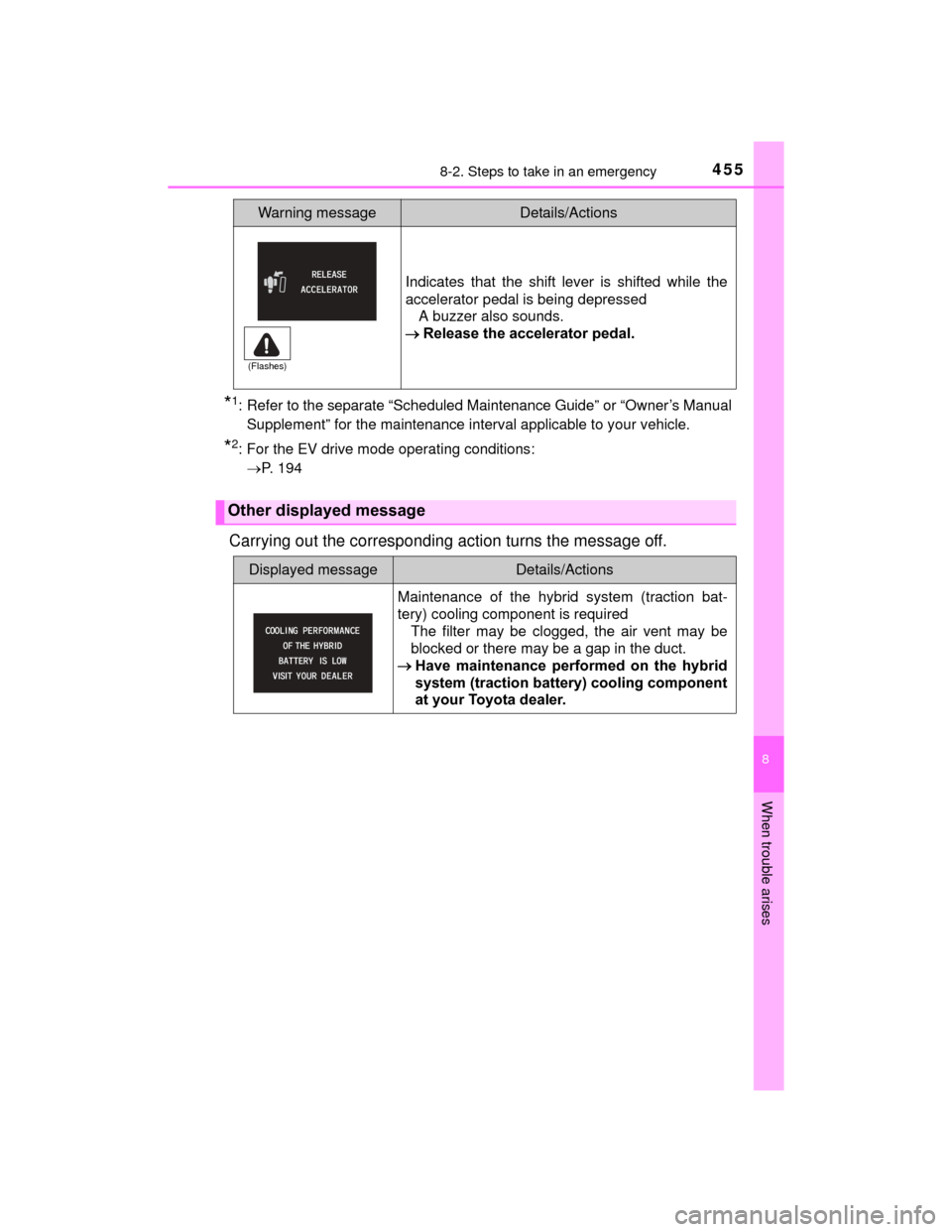ESP TOYOTA PRIUS C 2015 NHP10 / 1.G Service Manual
[x] Cancel search | Manufacturer: TOYOTA, Model Year: 2015, Model line: PRIUS C, Model: TOYOTA PRIUS C 2015 NHP10 / 1.GPages: 552, PDF Size: 9.47 MB
Page 403 of 552

4037-3. Do-it-yourself maintenance
7
Maintenance and care
PRIUS c_U (OM52E68U)■
Tire pressure warning system certification
U.S.A.
FCC ID: PAXPMVC010
NOTE:
This device complies with part 15 of the FCC Rules. Operation is subject
to the following two conditions: (1) This device may not cause harmful
interference, and (2) this device must accept any interference received,
including interference that may cause undesired operation.
FCC WARNING:
Changes or modifications not expressly approved by the party responsi-
ble for compliance could void the user’s authority to operate the equip-
ment.
Canada
NOTE:
Operation is subject to the following two conditions: (1) this device may
not cause interference, and (2) this device must accept any interference,
including interference that may cause undesired operation of the device.
NOTE:
L’utilisation de ce dispositif est autorisée seulement aux deux conditions
suivantes : (1) il ne doit pas produire de brouillage, et (2) l’utilisateur du
dispositif doit être prêt à accepter tout brouillage radioélectrique reçu,
même si ce brouillage est susceptible de compromettre le fonctionne-
ment du dispositif.
Page 447 of 552

4478-2. Steps to take in an emergency
8
When trouble arises
PRIUS c_U (OM52E68U)
WARNING
■Maintenance of the tires
Each tire, including the spare (if provided), should be checked monthly
when cold and inflated to the inflation pressure recommended by the
vehicle manufacturer on the vehicle placard or tire inflation pressure
label (tire and load information label). (If your vehicle has tires of a dif-
ferent size than the size indicated on the vehicle placard or tire inflation
pressure label [tire and load information label], you should determine
the proper tire inflation pressure for those tires.)
As an added safety feature, your vehicle has been equipped with a tire
pressure monitoring system (TPMS-tire pressure warning system) that
illuminates a low tire pressure telltale (tire pressure warning light) when
one or more of your tires is significantly under-inflated. Accordingly,
when the low tire pressure telltale (tire pressure warning light) illumi-
nates, you should stop and check your tires as soon as possible, and
inflate them to the proper pressure. Driving on a significantly under-
inflated tire causes the tire to overheat and can lead to tire failure.
Under-inflation also reduces fuel efficiency and tire tread life, and may
affect the vehicle’s handling and stopping ability.
Please note that the TPMS (tire pressure warning system) is not a sub-
stitute for proper tire maintenance, and it is the driver’s responsibility to
maintain correct tire pressure, even if under-inflation has not reached
the level to trigger illumination of the TPMS low tire pressure telltale (tire
pressure warning light).
Your vehicle has also been equipped with a TPMS (tire pressure warn-
ing system) malfunction indicator to indicate when the system is not
operating properly. The TPMS (tire pressure warning system) malfunc-
tion indicator is combined with the low tire pressure telltale (tire pressure
warning light). When the system detects a malfunction, the telltale will
flash for approximately one minute and then remain continuously illumi-
nated. This sequence will continue upon subsequent vehicle start-ups
as long as the malfunction exists. When the malfunction indicator is illu-
minated, the system may not be able to detect or signal low tire pres-
sure as intended.
TPMS (tire pressure warning system) malfunctions may occur for a vari-
ety of reasons, including the installation of replacement or alternate tires
or wheels on the vehicle that prevent the TPMS (tire pressure warning
system) from functioning properly. Always check the TPMS (tire pres-
sure warning system) malfunction telltale after replacing one or more
tires or wheels on your vehicle to ensure that the replacement or alter-
nate tires and wheels allow the TPMS (tire pressure warning system) to
continue to function properly.
Page 452 of 552

4528-2. Steps to take in an emergency
PRIUS c_U (OM52E68U)Indicates that the back door is not fully closed
If the vehicle reaches a speed of 3 mph (5
km/h), flashes and a buzzer sounds
to indicate that the back door is not yet fully
closed.
Close the back door.
(If equipped)
Indicates that the moon roof is not fully closed
(with the “POWER” switch off and the driver’s
door is open)
A buzzer also sounds.
Close the moon roof.
Indicates that the parking brake is still engaged If the vehicle reaches a speed of 3 mph (5 km/h),
flashes and a buzzer sounds to indicate
that the parking brake is still engaged.
Release the parking brake.
(U.S.A. only)
Indicates that all maintenance according to the
driven distance on the maintenance schedule*1
should be performed soon.
Comes on approximately 4500 miles (7200 km)
after the message has been reset.
If necessary, perform maintenance.
(U.S.A. only)
Indicates that all maintenance is required to cor-
respond to the driven distance on the mainte-
nance schedule*
1.
Comes on approximately 5000 miles (8000 km)
after the message has been reset.
(The indicator will not work properly unless the
message has been reset.)
Perform the necessary maintenance.
Please reset the message after the mainte-
nance is performed. ( P. 373)
Warning messageDetails/Actions
(Flashes)
(U.S.A.) (Canada)
(Red)
Page 455 of 552

4558-2. Steps to take in an emergency
8
When trouble arises
PRIUS c_U (OM52E68U)
*1: Refer to the separate “Scheduled Maintenance Guide” or “Owner’s ManualSupplement” for the maintenance interval applicable to your vehicle.
*2: For the EV drive mode operating conditions:P. 194
Carrying out the corresponding action turns the message off.
Indicates that the shift lever is shifted while the
accelerator pedal is being depressed A buzzer also sounds.
Release the accelerator pedal.
Other displayed message
Displayed messageDetails/Actions
Maintenance of the hybrid system (traction bat-
tery) cooling component is required
The filter may be clogged, the air vent may be
blocked or there may be a gap in the duct.
Have maintenance performed on the hybrid
system (traction battery) cooling component
at your Toyota dealer.
Warning messageDetails/Actions
(Flashes)
Page 486 of 552

4868-2. Steps to take in an emergency
PRIUS c_U (OM52E68U)
WARNING
■To prevent an accident or injury when inspecting under the hood of
your vehicle
●If steam is seen coming from under the hood, do not open the hood until
the steam has subsided. The engine compartment may be very hot, caus-
ing serious injuries such as burns.
● After the hybrid system has been turned off, check that on the
multi-information display and the “READY” indicator are off.
When the hybrid system is operating, the gasoline engine may automati-
cally start, or the cooling fan may suddenly operate even if the gasoline
engine stops. Do not touch or approach rotating parts such as the fan,
which may lead to fingers or clothing (especially a tie, a scarf or a muffler)
getting caught, resulting in serious injury.
● Do not loosen the radiator cap whil e the hybrid system and radiator are
hot.
Serious injuries, such as burns, may result from hot coolant and steam
released under pressure.
NOTICE
■ When adding engine/power control unit coolant
Wait until the hybrid system has cooled down before adding engine/power
control unit coolant.
When adding coolant, do so slowly. Adding cool coolant to a hot hybrid sys-
tem too quickly can cause damage to the hybrid system.
■ To prevent damage to the cooling system
Observe the following precautions:
●Avoid contaminating the coolant with foreign matter (such as sand or dust
etc.).
● Do not use any coolant additive.
Page 508 of 552

5089-1. Specifications
PRIUS c_U (OM52E68U)■
Temperature A, B, C
The temperature grades are A (the highest), B, and C, representing
the tire's resistance to the generation of heat and its ability to dissi-
pate heat when tested under controlled conditions on a specified
indoor laboratory test wheel.
Sustained high temperature can cause the material of the tire to
degenerate and reduce tire life, and excessive temperature can lead
to sudden tire failure.
Grade C corresponds to a level of performance which all passenger
car tires must meet under the Federal Motor Vehicle Safety Stan-
dard No. 109.
Grades B and A represent higher levels of performance on the labo-
ratory test wheel than the minimum required by law.
Warning: The temperature grades of a tire assume that it is properly
inflated and not overloaded.
Excessive speed, underinflation, or excessive loading, either sepa-
rately or in combination, can cause heat buildup and possible tire
failure.
Page 529 of 552

529
10
For owners
PRIUS c_U (OM52E68U)
AVERTISSEMENT
■Précautions relatives aux coussins gonflables SRS
Respectez les précautions suivantes concernant les coussins gonflables
SRS. Le non-respect de ces précautions peut occasionner des blessures
graves, voire mortelles.
●Le conducteur et tous les passagers du véhicule doivent porter correcte-
ment leur ceinture de sécurité.
Les coussins gonflables SRS sont des dispositifs supplémentaires à utili-
ser avec les ceintures de sécurité.
● Le coussin gonflable conducteur SRS se déploie avec une force considé-
rable, pouvant occasionner des blessures graves, voire mortelles, si le
conducteur se trouve très près du c oussin gonflable. L'autorité fédérale
chargée de la sécurité routière aux États-Unis (NHTSA) conseille:
La zone à risque du coussin gonflable conducteur se situant dans les pre-
miers 2 à 3 in. (50 à 75 mm) de déploiement, vous placer à 10 in. (250
mm) de votre coussin gonflable conduc teur vous garantit une marge de
sécurité suffisante. Cette distance est à mesurer entre le centre du volant
et le sternum. Si vous êtes assis à moins de 10 in. (250 mm), vous pou-
vez changer votre position de conduite de plusieurs façons:
• Reculez votre siège le plus possible, de manière à pouvoir encore atteindre confortablement les pédales.
• Inclinez légèrement le dossier du siège. Bien que les véhicules aient une conception différente, un grand nombre de conducteurs peuvent
s'asseoir à une distance de 10 in. (250 mm), même avec le siège con-
ducteur complètement avancé, simplement en inclinant un peu le dos-
sier de siège. Si vous avez des difficultés à voir la route après avoir
incliné le dossier de votre siège, utilisez un coussin ferme et antidéra-
pant pour vous rehausser ou remontez le siège si votre véhicule est
équipé de cette fonction.
• Si votre volant est réglable, inclinez-le vers le bas. Cela a pour effet d'orienter le coussin gonflable en di rection de votre poitrine plutôt que
de votre tête et de votre cou.
Réglez votre siège selon les recommandations de la NHTSA ci-dessus,
tout en conservant le contrôle des pédales, du volant et la vue des com-
mandes du tableau de bord.
Page 533 of 552

533
10
For owners
PRIUS c_U (OM52E68U)
AVERTISSEMENT
■Précautions relatives aux coussins gonflables SRS
●Si vous avez des difficultés à respirer après le déploiement des coussins
gonflables SRS, ouvrez une porte ou une vitre pour faire entrer de l'air
frais, ou bien descendez du véhicule si cela ne présente pas de danger.
Essuyez tout résidu dès que possible afin d'éviter d'éventuelles irritations
de la peau.
● Si les parties renfermant les coussins gonflables SRS, comme les garnitu-
res du volant et des montants avant et arrière, sont endommagées ou cra-
quelées, faites-les remplacer par votre concessionnaire Toyota.
● Ne placez rien sur le siège du passager avant, comme un coussin par
exemple. Cela a pour conséquence de répartir le poids du passager sur
toute la surface du siège, ce qui empêche le capteur de détecter correcte-
ment le poids du passager. En conséquence, les coussins gonflables fron-
taux SRS du passager avant risquent de ne pas se déployer en cas de
collision.
■ Modification et mise au rebut des composants du système de coussins
gonflables SRS
Ne mettez pas votre véhicule au rebut et ne procédez à aucune des modifi-
cations suivantes sans consulter votre concessionnaire Toyota. Les cous-
sins gonflables SRS peuvent ne pas fonctionner correctement ou se
déployer (se gonfler) accidentellement, provoquant la mort ou de graves
blessures.
● Installation, dépose, démontage et ré paration des coussins gonflables
SRS.
● Réparations, modifications, démontage ou remplacement du volant, du
tableau de bord, de la planche de bord, des sièges ou de leur garnissage,
des montants avant, latéraux et arrière ou des rails latéraux de toit.
● Réparations ou modifications des ailes avant, du pare-chocs avant ou des
flancs de l'habitacle.
● Installation d'un protège-calandre (pare-buffle, pare-kangourou, etc.), de
chasse-neige ou de treuils.
● Modifications du système de suspension du véhicule.
● Installation d'appareils électroniques tels que les émetteurs/récepteurs
radios mobiles et les lecteurs CD.
● Modifications de votre véhicule pour une personne atteinte d'un handicap
physique.